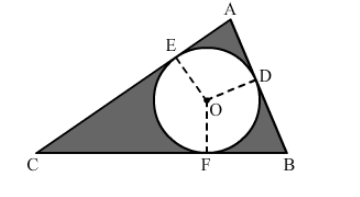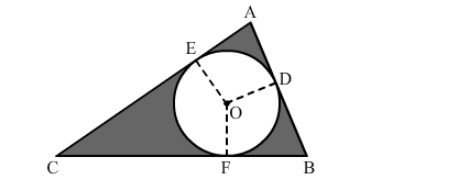In the given figure, ∆ABC is right-angled at A. Find the area of the shaded region if AB = 6 cm, BC = 10 cm and O is the centre of the incircle of ∆ABC.

Using Pythagoras' theorem for triangle ABC, we have:
$C A^{2}+A B^{2}=B C^{2}$
$C A=\sqrt{B C^{2}-A B^{2}}$
$=\sqrt{100-36}$
$=\sqrt{64}$
$=8 \mathrm{~cm}$
Now, we must find the radius of the incircle. Draw OE, OD and OF perpendicular to AC, AB and BC, respectively.

Consider quadrilateral AEOD.
Here,
$E O=O D$ (Both are radii.)
Because the circle is an incircle, AE and AD are tangents to the circle.
$\angle A E O=\angle A D O=90^{\circ}$
Also,
$\angle A=90^{\circ}$
Therefore, AEOD is a square.
Thus, we can say that $A E=E O=O D=A D=r$.
$C E=C F=8-r$
$B F=B D=6-r$
$C F+B F=10$
$\Rightarrow(8-r)+(6-r)=10$
$\Rightarrow 14-2 r=10$
$\Rightarrow r=2 \mathrm{~cm}$
Area of the shaded part = Area of the triangle
$=\left\{\frac{1}{2} \times 6 \times 8\right\}-\{\pi \times 2 \times 2\}$
$=24-12.56$
$=11.44 \mathrm{~cm}^{2}$
Click here to get exam-ready with eSaral
For making your preparation journey smoother of JEE, NEET and Class 8 to 10, grab our app now.
